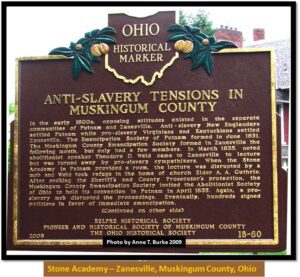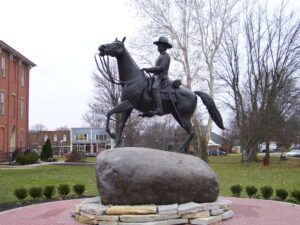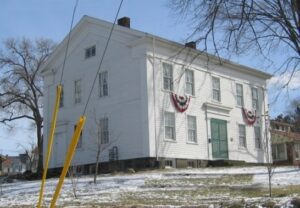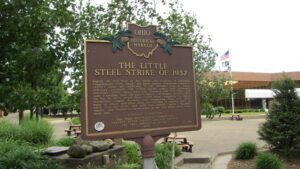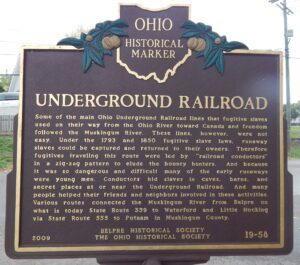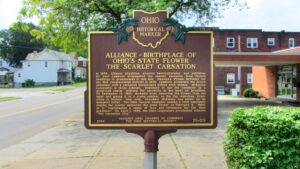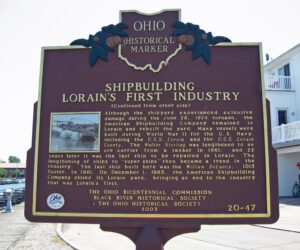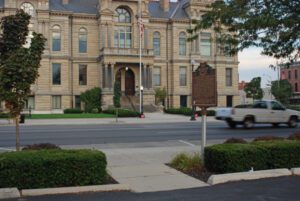, OH
In the early 1800s, opposing attitudes existed in the separate communities of Putnam and Zanesville. Anti-slavery New Englanders settled Putnam while pro-slavery Virginians and Kentuckians settled Zanesville. The Emancipation Society of Putnam formed in June 1831. The Muskingum County Emancipation Society formed in Zanesville the following month, but only had a few members. In March 1835, noted abolitionist speaker Theodore D. Weld came to Zanesville to lecture but was turned away by pro-slavery sympathizers. When the Stone Academy in Putnam provided a room, the lecture was disrupted by a mob and Weld took refuge in the home of church Elder A.A. Guthrie. After seeking the Sheriff’s and County Prosecutor’s protection, the Muskingum County Emancipation Society invited the Abolitionist Society of Ohio to hold its convention in Putnam in April 1835. Again, a pro-slavery mob disrupted the proceedings. Eventually, hundreds signed petitions in favor of immediate emancipation. [continued on other side]
, OH
W.S. Rosecrans, soldier, engineer, architect and inventor, was born in Kingston Township in 1819. After graduation from West Point in 1842, he served in the Engineering Corps then taught at West Point. As a civilian, he engineered a river lock system and perfected lamp oil. During the Civil War, Rosecrans commanded Union Armies of the Ohio, the Cumberland, and the Missouri, and developed a popular war-time ambulance. “Old Rosy” led his troops to victory at Iuka, Corinth, Stones River and Tullahoma. He helped raise $789,000 for soldiers’ relief and designed St. Joseph’s Cathedral in Columbus. He later served as Minister to Mexico, Registrar to the U.S. Treasury and as a Congressman from California. He died in 1898 and is buried in Arlington National Cemetery. “Stand by your flag and country, my men!”- Rosecrans at the Battle of Stones River, October 4, 1862
, OH
Built circa 1840 by Henry Barnhisel Jr. in the Greek Revival architectural style, the Barnhisel home is one of the oldest remaining structures in Girard. Henry and Eve Anna Barnhisel purchased the land where the house stands in 1813 when they acquired 318 acres in the Connecticut Western Reserve. The couple moved onto the land with their eleven children, and the family lived among a large group of Pennsylvania Germans who settled in Liberty Township. Their son, Henry Jr., took over the farm after his father’s death in 1824. In 1833 he married Susan Townsend. Henry contributed to his community by playing a key role in the building of both the Methodist Church and the first brick school in Girard and Liberty Township. He fathered five daughters, some of whom married into other leading families of the Mahoning Valley, including William Tod, son of the governor. Two granddaughters married into the Wicks and Stambaughs.
, OH
During the New Deal of the 1930s, the Congress of Industrial Organizations (CIO) formed the Steel Workers Organizing Committee (SWOC) under the leadership of CIO president John L. Lewis. Following successful CIO strikes in the rubber and automobile industries, SWOC signed hard-won contracts with U.S. Steel and Jones & Laughlin Steel, the nation’s largest steelmakers, in early 1937. On May 26 SWOC struck three “Little Steel” companies for similar recognition: Inland, Republic, and Youngstown Sheet and Tube, many of whose operations were concentrated in eastern Ohio. By early June the strike idled more than 28,000 Canton, Massillon, Warren, and Youngstown steelworkers in the first major steel strike since 1919. (continued on other side)
, OH
Some of the main Ohio Underground Railroad lines that fugitive slaves used on their way from the Ohio River toward Canada and freedom followed the Muskingum River. These lines, however, were not easy. Under the 1793 and 1850 fugitive slave laws, runaway slaves could be captured and returned to their owners. Therefore fugitives traveling this route were led by “railroad conductors” in a zig-zag pattern to elude the bounty hunters. And because it was so dangerous and difficult many of the early runaways were young men. Conductors hid slaves in caves, barns, and secret places at or near the Underground Railroad. And many people helped their friends and neighbors involved in these activities. Various routes connected the Muskingum River from Belpre on what is today State Route 339 to Waterford and Little Hocking via State Route 555 to Putnam in Muskingum County.
, OH
In 1866, Alliance physician, amateur horticulturalist, and politician Dr. Levi Lamborn propagated the scarlet carnation from French seedlings in greenhouses at this site. Opposing William McKinley for the 18th Congressional District in 1876, Lamborn presented the future president with a carnation boutonniere before each debate. McKinley, successful in those debates, continued to use the carnation as a good-luck charm, wearing the carnation in his lapel as president. On September 14, 1901, moments after removing the flower from his lapel and giving it to a young admirer at the Pan American Exposition in Buffalo, New York, President McKinley was killed by an assassin’s bullet. The Ohio General Assembly passed a joint resolution naming the scarlet carnation the state flower on February 3, 1904, as it “represented a token of love and reverence for the Ohio president.” On April 1, 1959, the Ohio Legislature proclaimed Alliance “The Carnation City.”
, OH
Lorain’s shipbuilding industry began when Augustus Jones and William Murdock began constructing wooden sailing vessels on the west side near the mouth of the Black River. The sloop General Huntington was the first boat launched from Lorain in 1819. In 1897, the shipbuilding industry moved to the east side of the river with the establishment of the Lorain yard of the Cleveland Shipbuilding Company, the precursor of the American Shipbuilding Company. In 1898, they were the largest dry dock on the Great Lakes. On April 13, 1898, the first steel ship, the Superior City, was launched. At the time, it was the largest vessel on fresh water. During the early years well-known passenger ships, railroad car ferries, tankers, self-unloaders, tugs, and barges were built here.
, OH
The Fugitive Slave Act of 1850 prompted an expansion of the “Underground Railroad,” and as the state spanning the shortest distance between the Ohio River and Canada, Ohio saw heavy traffic in escaping slaves in the decades before the Civil War. Hancock County was home to many sympathetic residents who defied fugitive slave laws to help conduct slaves to freedom. “Stationmasters” offered safe havens, “conductors” accompanied fugitives through the county, and “stockholders” provided financial support and misled pursuers. Known stations were located mainly along the Perrysburg Road, now U.S. Highway 68. (continued on other side)


